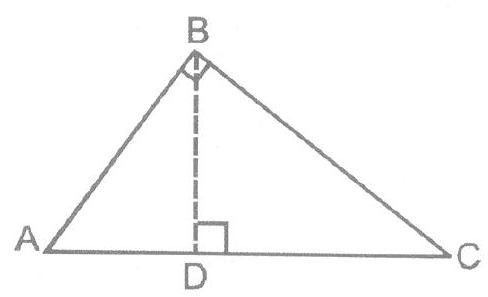knowledge-route Maths10 Ch5
title: “Lata knowledge-route-Class10-Math1-2 Merged.Pdf(1)” type: “reveal” weight: 1
TRIANGLES
TRIANGLES
8.1 CONGRUENT AND SIMILAR FIGURES:
Two geometric figures having the same shape and size are known as congruent figures. Geometric figures having the same shape but different sizes are known as similar figures.
TRIANGLES
8.2 SIMILAR TRIANGLES:
Two triangles ABC and DEF are said to be similar if their
(i) Corresponding angles are equal. i.e.
(ii) Corresponding sides are proportional i.e.
TRIANGLES
8.2 (a) Characteristic Properties of Similar Triangles :
(i) (AAA Similarity) If two triangles are equiangular, then they are similar.
(ii) (SSS Similarity) If the corresponding sides of two triangles are proportional, then they are similar.
(iii) (SAS Similarity) If in two triangle’s one pair of corresponding sides are proportional and the included angles are equal then the two triangles are similar.
TRIANGLES
8.2 (b) Results Based Upon Characteristic Properties of Similar Triangles :
(i) If two triangles are equiangular, then the ratio of the corresponding sides is the same as the ratio of the corresponding medians.
(ii) If two triangles are equiangular, then the ratio of the corresponding sides is same at the ratio of the corresponding angle bisector segments.
(iii) if two triangles are equiangular then the ratio of the corresponding sides is same at the ratio of the corresponding altitudes.
(vi) If one angle of a triangle is equal to one angle of another triangle and the bisectors of these equal angles divide the opposite side in the same ratio, then the triangles are similar.
(v) If two sides and a median bisecting one of these sides of a triangle are respectively proportional to the two sides and the corresponding median of another triangle, then the triangles are similar.
(vi) If two sides and a median bisecting the third side of a triangle are respectively proportional to the corresponding sides and the median another triangle, then two triangles are similar.
TRIANGLES
8.3 THALES THEOREM (BASIC PROPROTIONALITY THEOREM) :
Statement: If a line is drawn parallel to one side of a triangle to intersect the other sides in distinct points, then the other two sides are divided in the same ratio.
Given:
To Prove :

TRIANGLES
Construction : Join
Proof :
Area of
So,
Therefore,
Similarly,
And
Note that
So,
Therefore, from (i), (ii) and (iii), we have :
TRIANGLES
Corollary : If in a
(i)
(ii)
(ii)
(iv)
(v)

TRIANGLES
8.3 (a) Converse of Basic Proportionality Theorem :
If a line divides any two sides of a triangle in the same ratio, then the line must be parallel to the third side.
TRIANGLES
8.3 (b) Some Important Results and Theorems :
(i) The internal bisector of an angle of a triangle divides the opposite side internally in the ratio of the sides containing the angle.
(ii) In a triangle
(iv) The line drawn from the mid-point of one side of a triangle parallel to another side bisects the third side. (v) The line joining the mid-points of two sides of a triangle is parallel to the third side.
(vi) The diagonals of a trapezium divide each other proportionally.
(vii) If the diagonals of a quadrilateral divide each other proportionally, then it is a trapezium.
(viii) Any line parallel to the parallel sides of a trapezium divides the non-parallel sides proportionally.
(ix) If three or more parallel lines are intersected by two transversal, then the intercepts made by them on the transversal are proportional.
TRIANGLES
Ex. 1 In a
TRIANGLES
Sol. In
TRIANGLES

So, the required value of
TRIANGLES
Ex. 2
TRIANGLES
Sol. We have,
Now,
And,
TRIANGLES

Thus,
TRIANGLES
Ex. 3 In a trapezium
TRIANGLES
Sol.
TRIANGLES
From (i) and (ii), we get
In
TRIANGLES
Adding (iii) and (iv), we get
Hence proved.
TRIANGLES
Ex. 4 In
TRIANGLES
Sol. In
From A draw
[From (i)]

Hence Proved.
TRIANGLES
Ex. 5
TRIANGLES
Sol. It is given that
In
TRIANGLES
So, by AA-criterion of similarity
From (i) and (ii), we have

TRIANGLES
Ex. 6 In the given figure,
TRIANGLES
Sol. In
TRIANGLES

TRIANGLES
Ex. 7 In the given figure,
TRIANGLES
Sol. Since the diagonals of a trapezium divide each other proportionally.

TRIANGLES
8.4 AREAS OF SIMILAR TRIANGLS :
Statement: The ratio of the areas of two similar triangles is equal to the square of the ratio of their corresponding sides.
Given:
To Prove :
Construction: Draw altitudes
TRIANGLES
Proof :
Now, in
And
So,
Therefore,
TRIANGLES
Also,
So,
Therefore,
TRIANGLES
8.4 (a) Properties of Areas of Similar Triangles :
(i) The areas of two similar triangles are in the ratio of the squares of corresponding altitudes.
(ii) The areas of two similar triangles are in the ratio of the squares of the corresponding medians.
(iii) The area of two similar triangles are in the ratio of the squares of the corresponding angle bisector segments.
TRIANGLES
Ex. 8 Prove that the area of the equilateral triangle described on the side of a square is half the area of the equilateral triangle described on this diagonals.
TRIANGLES
Sol. Given : A square
To prove : Area
Proof : Since
TRIANGLES

TRIANGLES
8.5 PYTHAGOREOUS THEOREM :
Statement : In a right triangle, the square of the hypotenuse is equal to the sum of the square of the other two sides.
Given :
To prove :
Construction:
Proof :

TRIANGLES
So,
or,
Similarly
So,
or
Adding (i) and (ii),
or,
or
or,
TRIANGLES
8.5 (a) Converse of Pythagoreans Theorem :
Statement : In a triangle, if the square of one side is equal to the sum of the squares of the other two sides, then the angle opposite to the first side is a right angle.

Given :
Construction : Construct a triangle DEF such that
TRIANGLES
Proof :
In order to prove that
TRIANGLES
8.5 (b) Some Results Deduced From Pythagoreans Theorem :
(i) In the given figure

TRIANGLES
(ii) In the given figure, if

TRIANGLES
(iii) In any triangle, the sum of the squares of any two sides is equal to twice the square of half of the third side together with twice the square of the median which bisects the third side.
(iv) Three times the sum of the squares of the sides of a triangle is equal to four times the sum of the squares o the medians of the triangle.
TRIANGLES
Ex. 9 In a
(i)
(ii) area
TRIANGLES
Sol. (i) Here,
Clearly,
Thus, in
And
TRIANGLES
Now,

TRIANGLES
(ii)
TRIANGLES
Ex. 10
[CBSE-2006]
TRIANGLES
Sol. In
and In
TRIANGLES
Adding (1) and (2) and then multiplying by 4 , we get
TRIANGLES
[A line joining mid-points of two sides is parallel to third side and is equal to half of it,
Hence proved.

TRIANGLES
Ex. 11 In the given figure,
TRIANGLES
Sol. In
We have

TRIANGLES
Hence Proved.
TRIANGLES
Ex. 12
TRIANGLES
Sol. Through
Now,
Therefore,
So,
Therefore,
Now, from
TRIANGLES

Similarly, from
From
And form
TRIANGLES
Adding (i) and (ii)
Hence Proved.
TRIANGLES
Ex. 13
form
(i)
TRIANGLES
Sol. Let
Also,
Area of
TRIANGLES

(ii) Since
TRIANGLES
Ex. 14 In an equilateral triangle
TRIANGLES
Sol.
Draw
So,
In
TRIANGLES
From (i) and (ii)

TRIANGLES
DAILY PRACTIVE PROBLEMS 8
OBJECTIVE DPP - 8.1
TRIANGLES
1. The perimeters of two similar triangles are
(A)
(B)
(C)
(D)
TRIANGLES
| Qus. | 1 |
|---|---|
| Ans. | C |
TRIANGLES
2. In the following figure,
(A)
(B)
(C)
(D)

TRIANGLES
| Qus. | 2 |
|---|---|
| Ans. | A |
TRIANGLES
3. Two triangles
(A)
(B)
(C)
(D)
TRIANGLES
| Qus. | 3 |
|---|---|
| Ans. | B |
TRIANGLES
4. In a triangle
(A)
(B)
(C)
(D)
TRIANGLES
| Qus. | 4 |
|---|---|
| Ans. | B |
TRIANGLES
5.
(A)
(B)
(C)
(D)
TRIANGLES
| Qus. | 5 |
|---|---|
| Ans. | C |
TRIANGLES
6. In a
If
(A) 3.3
(B) 18
(C) 7.5
(D) 1.33

TRIANGLES
| Qus. | 6 |
|---|---|
| Ans. | C |
TRIANGLES
7. In a triangle
(A)
(B)
(C)
(D)
TRIANGLES
| Qus. | 7 |
|---|---|
| Ans. | B |
TRIANGLES
8.
(A)
(B)
(C)
(D)
TRIANGLES
| Qus. | 8 |
|---|---|
| Ans. | B |
TRIANGLES
SUBJECTIVE DPP - 8.2
1. Given

Find the lengths of segments DG and DE.
TRIANGLES
Sol. 1.
TRIANGLES
2. In the given figure,
(i)
(ii)
[CBSE - 2000]

TRIANGLES
Sol.2. (i)
TRIANGLES
3. In Figure,

TRIANGLES
Sol.3.
TRIANGLES
4. In figure,

TRIANGLES
Sol.4.
TRIANGLES
5. In the figure,

Find the lengths of PN and RM.
TRIANGLES
Sol.5.
TRIANGLES
6. In
TRIANGLES
Sol.6.
TRIANGLES
7. In a triangle
(i)
(ii)
(iii)
TRIANGLES
8. In figure,
TRIANGLES
9. In figure,

TRIANGLES
10. In a right triangle, prove that the square on the hypotenuse is equal to sum of the squares on the other two sides.
Using the above result, prove the following:
In figure

TRIANGLES
11. In
TRIANGLES
12. In figure,
[CBSE- 2000]

TRIANGLES
13. Any point
[CBSE-2002]

TRIANGLES
14. In figure,
TRIANGLES
15. The perpendicular
[CBSE - 2007]
TRIANGLES
16. Prove that the ratio of the areas of two similar triangles is equal to the ratio of the squares on their corresponding sides.
Using the above, do the following :The diagonals of a trapezium
[CBSE - 2008]
TRIANGLES
Sol.16.
TRIANGLES
17.
TRIANGLES
Sol.17.
TRIANGLES
18.
TRIANGLES
19. In figure,
[CBSE - 2008]











